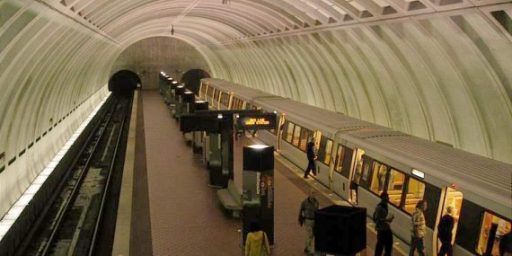Public Transit Realities
Matt Yglesias reviews Sim City 4 and laments the fact that “the game is curiously optimistic about middle class people’s willingness to ride a bus to a subway station then take a subway then get on another bus and take that to work. Maybe when gas costs $20 a gallon, but in the real world I think people who aren’t in desperate financial straits are only going to use transit if it’s reasonably convenient.”
Damn straight. And that’s as it should be.
There are plenty of reasons to desire as a society that more people use mass transit. But we shouldn’t expect that this will happen out of some sense of altruism. Rather, we should get about the business of figuring out how to make it reasonably desirable, preferably directly rather than by penalizing driving. My instinct is that, aside from people living in a handful of metropolitan areas, it’s just not feasible. But that would still cover a whole lot more people than it does now.
The DC Metro rail system is reasonably clean and safe and I’d use it a lot more than I do now if 1) there were a stop within walking distance of my house, 2) trains ran with sufficient frequency, 3) I were able to get to my destination with reasonable speed and undue fuss. And, yes, I realize goals 1 and 3 are difficult to realize given the existence of non-me ridership.
The generally touted quick fix is some sort of rapid transit bus system which has all manner of advantages over rail. Unfortunately, for reasons that I don’t at all understand, bus systems almost immediately degenerate into lowest common denominator experiences. The DC Metro bus system, certainly, is a relative nightmare as compared to MetroRail.






Uh, it’s not hard to understand at all: most of us live in neighborhoods which were the result of subsidized sprawl and the artificially cheap automobile. Those who live in urban environments have no trouble using trains.
As for buses, they’re fundamentally loathed for transit service for those who have a choice (people who can afford cars) – which is why cities end up building light rail these days. It’s not all subjective, either; there are big problems even with the true “bus rapid transit” treatments which make rail a better choice.
Way back at the dawn of time (as my children refer to my past, you might think of it as the early 1980’s) I got a summer job with a law firm. They gave me a bonus directed towards the cost of commuting, specifically the high cost of downtown parking. There was a bus stop within walking distance of my house which took me to the block the law offices were on. I pocketed the ‘parking subsidy’ and took the bus. Given traffic congestion, it took quite a while in both directions. I had a car, but it was much cheaper to use the bus.
Now if I was a lawyer with the same firm pulling down the big bucks even a fresh out gets, I wouldn’t have ridden the bus. But for the peons, the suburbs to the center city worked pretty well.
My father would have had to do the same ride to the center city and then transfer to another bus to get to work (effectively doubling his commute time). I may have lost a few minutes by riding the bus vs car, but not that much.
Bottom line is that the mass transit needs to be reasonably convenient, safe (remember Obama’s grandmama getting thrown under the bus by Obama because she was afraid of getting mugged while waiting for a bus) and offer advantages over driving (lower costs, ability to sit back and not fight traffic, etc).
The problem with “fixed rail” is that it is “fixed”. If a once suburban or rural area becomes built up and one other area (formerly urban) becomes rundown or abandoned, then re-routing the rail lines becomes prohibitively expensive. Buses, on the other hand, can be re-routed more easily. If the bus line becomes run down that is the fault of the management, not the transportation mode.
Out here in Seattle’s latte’land- we are looking at BILLIONS for light rail and very little for other transportation. Would love to hear ideas for privatizing mass transit.
This would be easy–just cut the subsidies for driving and make drivers pay the true costs.
You are actually seeing a rise in ridership throughout the country in various mass transit systems that has been attributed to higher gas prices. The higher prices, of course, are due to supply issues–not because the subsidies have been reduced. If you had true pricing for private automobiles there would be much more demand for transit (and demand for sensible land use policy, which is intimately related).
MIEK – They have no problem subsidizing mass transit to keep the fares low to get people to ride.
I have thought about the Commuter Bus or Train, either was I have to drive 3 to 4 miles and find parking to ride. The Bus Stop is the last on the line and the train is not a direct downtown route so taking either form of mass-transit adds at least an hour to my daily commute, just in transit time.
For most of my adult life, I’ve worked in the Downtown area of Rochester, at one job or another. For the first year or so, and on and off after that, I tried using the bus. After getting mugged twice, having bums hassle me for change, (Which I never carry anyway) having people smell up the bus with various remarkable bodily functions, having one person puke on me, and having my jouneys take often as not an hour longer than a car trip would have taken, I gave up on government transport.
I’ve ridden on rail systems, which admittedly were marginally better, (DC and the TTC) but even in those sitations, being totally dependant on such systems being on time proved problematic when they were not.
I will tell you that in rcent years, the TTC rail is showing signs of going the way of the less desireable bus systems, in that one of the first things I did on a recent visit to the GTA was trip over a kid in a sleeping bag coming out of the Bloor street station.
Granted, that’s a function of the neighborhood going to hell, but that’s part of the point; In my truck I never run into such problems, regardless of neighborhood conditions, particularly if the employer is good enough to provide an enclosed parking space, which I usually get as a part of my employee negotiations.
For me, this is not simply a matter of cost, but of function, particularly where getting back and forth to work is concerned.
(Fascinating fact: It’s hard to give a good impression to a customer when your clothing smells like beer and vomit. Who knew?)
Get your facts straight. In the city’s 2008 budget $1.8 million was budgeted for the Streetcar and $5.5 million was budgeted for transit enhancements (and High Occupancy Vehicle lanes)
$8.2 million was adopted JUST FOR THE TRAFFIC SIGNALS PROgram–4.7 million just for street markings. 19 MILLION just for one viaduct improvement at Spokane Street. The road maintenance budget is 24 million.
If you look at the life of transportation projects, transit outlays are much more efficient per capita than highways.
Damn, you mean that’s what I’ve been doing wrong!?
But seriously, it’s funny you should post on this today. Over at ajc.com (Atlanta Journal-Constitution) there is a story with discussion on why more people don’t use MARTA. Now, if any of you here is familiar with MARTA you already know the answer. For those who don’t MARTA exists to transport people withing the confines of the city. In very few area does it reach out into the ‘burbs. It’s not designed to effectively get people from the outlying residential areas into the city. Hell, even within the city you’re lucky if you can find a route to get you from point A to point B with a minimum of fuss.
Now all of this would be forgivable is there wasn’t a single city in the US with a highly functional mass transit system. But that’s not the case.
I’m starting to think that the best barometer for judging if a city is really willing to do what it takes to be a “big” city is whether they’ve planned for a useful mass transit system.
The reason that MARTA doesn’t go out to the suburbs is because white voters in Cobb and Gwinett Counties rejected being connected to the system in 1971–largely because of white racist fears of African Americans. The race dynamic is discussed in Bob Bullard’s interesting book on Atlanta, “Sprawl City.”
Maybe the designers are European or Japanese where that is not at all uncommon.
My commute to the lab was ~15 min on the bus (or about the same on my bike), 35 min on the train, then 5 min on the Metro and 5 min walking. I would save about 15 min driving if I was lucky with traffic and parking, if not it could be worse. I could read some articles on the bus and train or just zone out on music or puzzles. I much preferred that to my typical commute in the US.
Not everyone lives and works in a metro area.
I live and work in a small rural town. And I don’t see mass transit becoming a doable industry for this type of town. I think it works well for cities and suburbs of cities, but small towns of less than a few thousand people just aren’t going to be able to develop a workable and affordable system.
Yes, and in Europe, small towns don’t have much mass transit either – but because they don’t subsidize suburban sprawl and automobile use, they end up with little walkable towns so you don’t need to drive so damn much.
As for subsidized fares, they’re meaningless – the variable cost of driving is so low that you can’t really save significant money by taking the bus unless you have to pay an awful lot to park your car. Most people get this wrong by assuming that their car depreciates mostly per-mile; when it’s actually per-year. More here: http://mdahmus.monkeysystems.com/blog/archives/000483.html
Triumph, I know. The part that irks me is that the last time it was voted on was 1971. I fail to understand how a city can fight so hard to reach a level of national prominence while simultaneously doing nothing to prepare for the fact that lots of people will want to move to it.
As for keeping African Americans (and Mexicans) out of Gwinett and Cobb, that ship sailed ages ago. Might as well let MARTA in now.
AHA! I wondered when that fact would leak out. That Marta is still not out there, despite there being a fair number of blacks and Mexicans out there, raises the logical question if racism is really the cause for Marta’s not being approved, or if there’s something else at work, there.
I’ll tell you a little story: There’s a government-run and owned low-income housing project near where I grew up. When it originally went in there was a flurry of activity against it. Of course the federal government, being the federal government, blew away all the zoning board objections and the objections of the locals and crammed it in anyway. Of course, we were all told that the reason we obkected to the place going up is we were all racists. This despite acknowledgement from both sides that the vast majority of the people in the place would be WHITE. That was 25 years ago and more… and the population inside the place remains nearly 80% white. And the objections to the place persist.
Perhaps there’s something else besides race driving the objections. Can you imagine what they might be complaining about, Triumph?
Public transportation systesm exist in the large part to move people in and out urban centers. Aside from three weeks of grand jury duty, I have never had a job in city center. Those three weeks were the only time in my life that public transportaion would have been a viable option.
People won’t take public transportation is can’t get them where they need to go, adn the large part is simply doesn’t.
I live in the city of Boston and take the commuter train everyday. Thank you all for paying for it along with the Big Dig. Mass transit only works when other people pay for it so thanks.